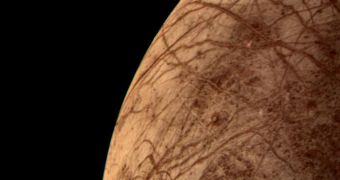In spite of the fact that the Jupiter moon Europa is one of the most interesting places for science in the entire solar system, a flagship-class mission to investigate it in detail may no longer be on the table.
Officials at NASA hinted at the fact that the budget allotted for planetary probes may decline at the space agency over the next five years. The news comes from the NASA Advisory Council planetary science subcommittee.
These budgets are currently either flat or declining, and there is little hope that they will be improved markedly in the coming years. When it comes to exploring Europa, we are talking about a spacecraft comparable to the Cassini probe around Saturn or the Mars Reconnaissance Orbiter (MRO).
Creating such a space probe takes many years, and NASA hasn't even begun the earliest stages of preparing for a mission to Europa. The idea is pretty much still a concept in people's heads.
It will be interesting to see what level of priority the US National Academy of Sciences will give a flagship mission to the Jovian moon. Next week, the organization will release its decadal review of priorities for planetary sciences for 2013-2022.
The document holds great significance for informing the American space agency's exploration plans. If the NASA classified an Europa mission as a high-priority objective, then perhaps NASA would somehow manage to get the necessary level of funding.
However, that seems unlikely to happen, commentators point out. “The out-years budget means no major new starts of a flagship planetary [mission],” explains professor Ronald Greeley.
“That’s a major, major issue for our community,” said the expert, who holds an appointment as the chairman of the NASA Advisory Council’s planetary science subcommittee. He is also a regent’s professor at the Arizona State University (ASU), in Tempe.
At this point, the expert told in a conference on March 1, the Mars Science Laboratory (MSL) Curiosity is the only flagship-class planetary mission under development at NASA. The mission costs $2.5 billion, Universe Today reports.
The medium-class “New Frontiers” mission Juno, which is scheduled to launch for Jupiter this August, is not poised to study any of the gas giant's moons. It will focus exclusively on the planet.
“How we will implement [the decadal priorities] within our existing budget needs to be considered. [There are] no additional money beyond the president’s submitted budget,” explained at the same conference the director of the NASA Planetary Science Division, Jim Green.

 14 DAY TRIAL //
14 DAY TRIAL //